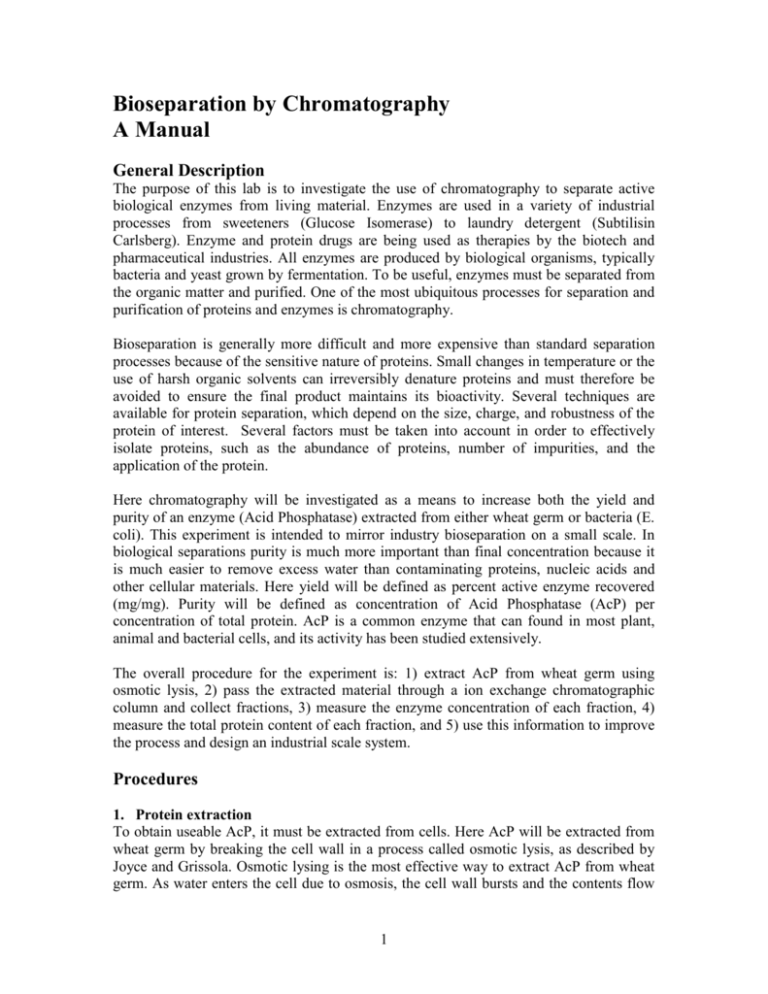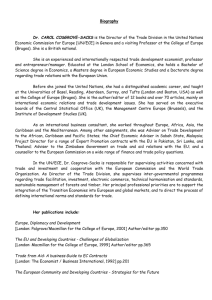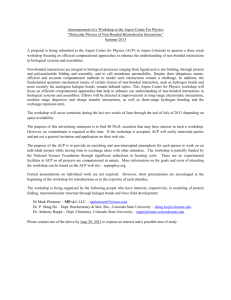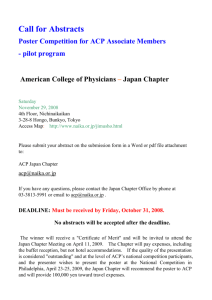Bioseparations Manual
advertisement

Bioseparation by Chromatography A Manual General Description The purpose of this lab is to investigate the use of chromatography to separate active biological enzymes from living material. Enzymes are used in a variety of industrial processes from sweeteners (Glucose Isomerase) to laundry detergent (Subtilisin Carlsberg). Enzyme and protein drugs are being used as therapies by the biotech and pharmaceutical industries. All enzymes are produced by biological organisms, typically bacteria and yeast grown by fermentation. To be useful, enzymes must be separated from the organic matter and purified. One of the most ubiquitous processes for separation and purification of proteins and enzymes is chromatography. Bioseparation is generally more difficult and more expensive than standard separation processes because of the sensitive nature of proteins. Small changes in temperature or the use of harsh organic solvents can irreversibly denature proteins and must therefore be avoided to ensure the final product maintains its bioactivity. Several techniques are available for protein separation, which depend on the size, charge, and robustness of the protein of interest. Several factors must be taken into account in order to effectively isolate proteins, such as the abundance of proteins, number of impurities, and the application of the protein. Here chromatography will be investigated as a means to increase both the yield and purity of an enzyme (Acid Phosphatase) extracted from either wheat germ or bacteria (E. coli). This experiment is intended to mirror industry bioseparation on a small scale. In biological separations purity is much more important than final concentration because it is much easier to remove excess water than contaminating proteins, nucleic acids and other cellular materials. Here yield will be defined as percent active enzyme recovered (mg/mg). Purity will be defined as concentration of Acid Phosphatase (AcP) per concentration of total protein. AcP is a common enzyme that can found in most plant, animal and bacterial cells, and its activity has been studied extensively. The overall procedure for the experiment is: 1) extract AcP from wheat germ using osmotic lysis, 2) pass the extracted material through a ion exchange chromatographic column and collect fractions, 3) measure the enzyme concentration of each fraction, 4) measure the total protein content of each fraction, and 5) use this information to improve the process and design an industrial scale system. Procedures 1. Protein extraction To obtain useable AcP, it must be extracted from cells. Here AcP will be extracted from wheat germ by breaking the cell wall in a process called osmotic lysis, as described by Joyce and Grissola. Osmotic lysing is the most effective way to extract AcP from wheat germ. As water enters the cell due to osmosis, the cell wall bursts and the contents flow 1 out into solution. The resulting solution contains AcP as well as many other cellular components. Prepare 0.3 M Acetic Acid Buffer Solution o 20.5g anhydrous sodium acetate o 2.86 ml acetic acid o In 1000 ml DI water o Adjust the pH to 5.5 Make a 0oC ice water bath in a large container and place on stir plate Add 250ml buffer solution in a 500ml Erlenmeyer flask with stir bar Mash 25gm dry wheat germ using mortar and pestle Add to chilled buffer solution Stir for 30min Filter the slurry through 2 layers of cheese cloth to remove large solids Vacuum filter the slurry into a 2L Erlenmeyer vacuum flask and keep on ice o Perform Course Filtration with Coffee Filter First This filtration may require changing filters o Perform Fine Filtration using Laboratory Filter Paper This filtration may require changing filters Test the extract for total protein and AcP specific activity as described below Aliquot AcP extraction into 15mL centrifuge tubes for future use Freeze Aloquotted samples until they are needed for separation Prior to separation o Warm frozen sample in cool water until it is totally melted o Centrifuge Sample for 10min at HighRPM Protein stability Note that extracted proteins can be very unstable and enzymes quickly lose their activity. If possible, all procedures should be performed at 0oC. Also, if analysis is not completed in a single lab session, extracts and samples should be frozen at -20°C. Be certain to not freeze and thaw the samples multiple times as it can lead to protein instability. 2. Chromatography Chromatography works on the principle that different molecules travel through porous charged media at different rates. When cell extract is passed through a packed column, some components will exit quickly, and others will be retained. There are several different effective packing materials. The most common resins are size exclusion, hydrophobic, and ion exchange. In this investigation, ion exchange resin will be used. Ion exchange resin is comprised of charged particles which interact with the fluid passing through the column. Depending on the charge and polarity of the passing molecules, some will interact more strongly with the resin than others, and thus change the rate of flow. Pack a 20 cm chromatography column to 1/3 of its height (6.7cm) with desired resin 2 o Column Height can be adjusted in later experimentation but results are obtained for this height Rinse resin with 100mL of acetate buffer prior to loading in the column o DEAE resin must be rinsed in the column Load the resin in the column o Be certain to load the resin wet Rinse resin with an additional 10mL of fluid when it is packed o Be certain to not let the column run dry Label 10 - 25 1.5ml centrifuge tubes for fraction collection Charge the column with a 1-2ml plug of AcP extract Allow the extract to entirely absorb into the resin. Once absorbed, fill the head space of the column with acetate buffer o Use a Pasteur Pipette as to not disturb the resin Collect 1 mL (or smaller) fractions into pre-labeled 1.5 ml centrifuge tubes Carefully maintain the level of buffer to keep a constant rate of elution Test each fraction for total protein and AcP specific activity (as described below) 3. Acid phosphatase assay In this experiment enzyme concentration will be determined by measuring a reaction rate. The rate of an enzymatic reaction is dependent on both the concentration of the substrate (S) and the concentration of the enzyme (E0). In most enzyme catalyzed reactions, the reaction rate slows as the concentration of the substrate gets large. This non-linear dependence is typically described with the Michaelis-Menten equation: 3 v vmax S k2 E0 S Km S Km S (1) In this equation, v is the rate of the reaction ( dS dt ), vmax is the maximum reaction rate, and Km is the Michaelis constant. When S = Km the reaction velocity is half of the maximum. If the substrate is present in excess (i.e. S >> Km), Equation (1) becomes v k2 E0 (2) This relation is useful because the reaction rate is linearly proportional to the enzyme concentration. AcP belongs to a class of enzymes that remove phosphate groups from other molecules (phophatases). The activity of the AcP enzyme can easily be measured because it catalyzes the conversion of p-nitrophenyl phosphate (PNP) into p-nitrophenol, which is in equilibrium with p-nitrophenoxide. Both PNP and p-nitrophenol are colorless, but pnitrophenoxide is strongly yellow in color, which enables simple detection of the reaction product by spectrophotometry. BASE ACP p-nitrophenyl phosphate p-nitrophenol p-nitrophenoxide Colorless Substrate Rather than traditional mass per volume or mole per volume, enzyme concentrations are commonly expressed in units of activity. A unit of enzyme can convert a specified amount of substrate over a certain time. An activity unit of AcP converts 1 μmole of PNP per minute. Units are used to describe enzyme activity because conditions (temperature, pH) and even organism of origin affect activity. Activity units can be converted to more standard concentration units, e.g. mg/ml, if a standard conversion is known. The most straightforward method to determine the activity of a solution would be to add a high concentration of PNP and measure the appearance of yellow color (p-nitrophenol) as a function of time. This technique is described in a supplemental section (Dynamic AcP calibration curves) below. However, this technique is time intensive and difficult to complete in the time of a typical lab. To reduce the number of required spectrophotometer reading, we can assume that the reaction rate is linear for the first 5 minutes after the addition of PNP. This assumes that the substrate is not significantly 4 consumed during this time, i.e. S>>Km. The single-time-point method is also simplified by the addition of a Stop Solution which eases sample handling. For this method, the reaction rate (and the enzyme activity) is defined as the amount of formed p-nitrophenol in the reaction time (nominally 5 minutes). Single Time Point method to determine AcP Activity The following procedure was adapted from the instructions provided with Sigma Acid Phosphatase Assay Kit (Cat#CS0740) Prepare the AcP assay solutions: o Substrate Solution 2 PNP tablets in 10 ml Citrate Buffer Solution o Stop Solution (0.5N NaOH Solution) 5g Solid NaOH 250ml DI water (add the NaOH to the water to prevent rapid heating) o AcP Positive Control Solution 0.5g AcP enzyme 1000ml DI water Note the activity (unit/mg) of AcP used Add the reaction components to tubes to create a blank, positive control, and experimental tubes o Blank 450 ul Substrate Solution 50 ul Acetate Buffer o Positive control 50μl AcP Control Solution 450μl Substrate Solution o Experimental tubes 50μl test solution (This is typically crude extract or chromatography fractions) 450μl Substrate Solution o The ratio can be adjusted to 100μl test solution to 400μl Substrate Solution if absorbances are too low (Absorbances between 0.5 and 1.0 are ideal). This can be accounted for in the equation below. Vortex tubes briefly Allow tubes to react for exactly 5 minutes (measure the time for each tube) o This time can be increased if yellow color does not appear Stop the reactions with 1 ml of Stop Solution. The colored solution formed after the addition of the 0.5 N NaOH is stable for several hours. Transfer the reaction mixture to a cuvette and measure the absorption at 405 nm Calculations Calculate the amount of product formed in the reaction. The concentration of pnitrophenoxide in the tubes can be found based on Beer’s Law. For pnitrophenoxide, the extinction coefficient (ε) is 0.546 mM/(1 Absorbance unit). 5 blank A 405 [p-nitrophenoxide] = A sample 405 For AcP, 1 unit is defined as the amount of enzyme that hydrolyzes 1 μmole pf PNP per minute. The number of units in each experimental solution can be found by simple conversion. Units/ml = (3) [p-nitrophenoxide] total volume time test volume (4) For the standard case, the total volume (of the reaction) is 3ml, the time is 5 minutes, and the test volume is 10μl. Calculate the units/ml for the positive AcP control. Use this value and the known mass of added enzyme (0.5 mg/ml) to calculate the mass of AcP in each test volume. Dynamic AcP calibration curves (supplemental) The above procedure is the simplest method for calculating the concentration of AcP in a test solution. More accurate measurements can be made by measuring the appearance of p-nitrophenoxide as a function of time. An AcP calibration curve can be constructed using by measuring the reaction rate with known quantities of AcP. Create a library of AcP solutions with known activities ranging from 0.01 to 0.1 units/ml. A reasonable list would be (0.01, 0.025, 0.05, 0.075, and 0.1). Add 10μl of each of these standard solutions to 990μl Substrate Solution in a 1ml cuvette. Measure and record the absorbance at 405 nm every 30 seconds Convert each absorbance into concentration according to Beer’s Law (Eq. 3) Determine the initial slope of each concentration vs. time plot. This is the activity of the standard solution. The slope of a test solution can be compared to this standard to obtain units/ml and mg/ml (of enzyme) as described above. 4. Total protein assay The following procedure was adapted from the instructions provided with Sigma Total Protein Assay Kit (Cat#TP0400), which uses the Micro Pyrogallol Red Method. This method uses two reagents that are supplied pre-made: Total Protein Reagent and Protein Standard Solution Warm the Total Protein Reagent to room temperature Set up a series of labeled 1.5ml micro-centrifuge tubes for Blank, Standard, and Tests Pipette 1.0 ml of the Total Protein Reagent into each tube 6 Pipette 20 μl (0.02 ml) of water, Protein Standard Solution, and samples to appropriately labeled test tubes Mix by gentle inversion Incubate tubes for 3 minutes at room temperature Read and record the absorbance (A) of Blank, Standard, and Tests at 600 nm using water as the reference. Absorbance reading is stable for 15 minutes. Subtract the absorbance of Blank from the absorbance of Tests and Standard to obtain change in absorbance (ΔA) due to protein. Calculate the protein concentration of the sample. Protein conc. (mg/ml) = A Test A Blank Standard conc. (0.5 mg/ml) AStandard A Blank (5) 5. Salting out To isolate AcP, it is necessary to separate out this extraneous material which can include hundreds of different proteins. One common purification procedure is referred to as “salting out.” This procedure is designed to create an unfavorable environment for a majority of proteins while simultaneously maintaining a tolerable environment for a much more narrow range of proteins - including AcP. By increasing the salt concentration, many proteins will fall out of solution. The proteins interact with the charged ions and form a complex which can be isolated and removed by centrifugation. Note that the best purification may not require all three salting out steps. Prepare three salt solutions: 1M Manganese Chloride Solution, 35% Ammonium Sulfate Solution, and 57% Ammonium Sulfate Solution o Add 12.58 g MnCl2 to 100ml DI water o Add 59.8 g Ammonium Sulfate to 300ml DI water (for 35% solution) o Add 173.8 g Ammonium Sulfate to 500ml DI water (for 57% solution) To the crude AcP extract add 2% (v/v) of 1M MnCl2 Stir for 15 minutes at 0°C Transfer solution to 4 centrifuge tubes and centrifuge for 10min at high RPM to remove suspended particles Combine supernatants into 500ml Erlenmeyer flask Measure the total protein and AcP concentration Add 50% (v/v) of 35% ammonium sulfate Stir for 15 minutes at 0°C Transfer solution to 4 centrifuge tubes and centrifuge for 10min at high RPM Combine supernatants into 500ml Erlenmeyer flask Measure the total protein and AcP concentration Add 75% (v/v) of 57% ammonium sulfate Stir for 15 minutes at 0°C Transfer solution to 4 centrifuge tubes and centrifuge for 10min at high RPM 7 Combine supernatants into 500ml Erlenmeyer flask Measure the total protein and AcP concentration 6. Enzyme extraction from bacteria (supplemental) A more industrially relevant organism for the production of enzymes is bacteria, specifically E. coli. Conveniently E. coli natively produce Acid Phosphatase without induction. To extract AcP from E. coli, the bacteria need to be grown and their protein fraction extracted using a method similar to that used for wheat germ. Many of the parameters that enhance AcP production in bacteria culture and enable a high yield from the extraction have not been optimized. Optimization of these techniques is an excellent goal for a lab project. The growth of bacteria can be coupled with the fermentation project. The E. coli strain K12 was provided by Prof. Steven Sandler of the Microbiology Department. This strain is non-pathogenic and is believed to produce AcP. E. coli strain K12 grows well in triptone luria broth, which may enhance AcP production. Previous research suggests that glucose-based growth media retards AcP production. Peptonebased, or the similar chemical triptone, media amplifies AcP growth in bacteria. The following describes a procedure to grow E. coli and extract AcP. Basic batch growth of bacteria Prepare triptone growth media (LB) o 5g yeast extract o 10g triptone o 10g NaCl o 1L DI water Prepare LB agar for plates o 5g yeast extract o 10g triptone o 10g NaCl o 2% (w/v) agar o 1L DI water Prepare agar plates by pouring 30ml LB agar (autoclaved) into Petri dishes (10X). Streak bacterial culture from frozen stock on agar plates. Incubate overnight at 37°C. Select one distinct colony to inoculate 2 ml of sterile LB broth (media; use autoclave to sterilize) Grow at room temperature (37°C is preferred if possible) for 48 hrs. Store at 4°C if necessary Protein extraction from bacteria Centrifuge the bacterial solution at high RPM for 5 minutes Discard supernatant (remove as much as possible without disturbing pellet) Add 1 ml ice cold 0.3 M Acetic Acid Buffer Solution 8 Mix by inversion Shake for 10 minutes at 0oC Centrifuge solution at high RPM for 5 minutes Decant the supernatant and store as “Bacterial AcP Extract” Test the extract for total protein and AcP specific activity as described above 9 Typical experiments These are a couple of questions that can be investigated. Results obtained from initial investigations are reported in Sample Results below. The supplied additional questions give alternate directions each group can use to approach the experiment. 1. Which fraction has the highest purity ratio? Which fraction has the highest yield? 2. Which fraction would you use in an industrial process? How would you deign the corresponding separation scheme? Additional questions to investigate 1. Does decreasing fraction size provide more information about the separation process? Does this make it easier to specify the optimal procedure? 2. Does changing the chromatographic packing material improve either the purity ratio or the overall yield? Materials to try include cationic exchange resins, size exclusion resins, and hydrophobic resins. Resins such as DEAE-cellulose and Sephadex G-75 (size exclusion) have often been shown to provide good separation of AcP. 3. Does salting out prior to chromatography improve the yield and/or the purity ratio? Which salting out procedure performs the best? Does eliminating or modifying the Manganese Chloride and Ammonium Sulfate solutions improve the performance? 4. Can AcP be extracted from bacteria? Which growth conditions encourage production of AcP? Which food source is favorable: glucose, triptone, or another carbon source? 5. What are the optimal conditions for cell lysis? a. Can more AcP be isolated if more bacteria are cultured (grow 100ml instead of 2ml) b. Is the acetate buffer the best buffer for lysis? Does ice-cold DI water isolate more AcP? Is there a better buffer? c. If AcP is not present in the supernatant, where is it? Can acticvity be detercted in the bacgterial slurry? Is there activiry in the original growth medium? d. Does a higher centrifuge speed increase AcP yield? (Higher RPM can be obtained using a microcentifuge) 10 Sample results The use of fractional chromatography proved that AcP can be purified using anionic exchange resins. The AcP and total protein concentrations was measured in the first 10 fractions out of the column (Figure 1). Three of the fractions, 6-8, had higher concentration of AcP than the extract (Figure 2). Fraction eight, corresponding to a time of approximately 42 minutes, had the highest purity of AcP (Figure 3). In fraction eight, 22 percent of the total AcP charged to the column came out in this fraction versus only 1.2 percent of the total amount of protein. This is a desirable ratio of AcP to total protein with large quantity recovered. After taking an AcP assay and measuring solution absorbance with the spectrophotometer, it was determined that the activity of AcP in the crude extract was approximately 0.06units/ml. This is equivalent to 0.1223mg AcP /ml. Concentration (mg/mL) 1.4 1.2 Total Protein ACP 1 0.8 0.6 0.4 0.2 0 1 2 3 4 5 6 7 8 9 10 Fraction No. Figure 1. Concentrations of protein and AcP in chromatographic fractions Concentration Enhancement 7 6 5 4 3 2 1 0 1 2 3 4 5 6 7 8 9 10 Fraction No. Figure 2. Enhancement of concentration in the chromatographic fractions 11 Purity (mg AcP/mg Protein) 20 18 16 14 12 10 8 6 4 2 0 1 2 3 4 5 6 7 8 9 10 Fraction No. Figure 3. Purity of AcP in the chromatographic fractions Dynamic AcP Calibration 0.4 Slope (Abs/time) 0.35 0.3 0.25 0.2 0.15 y = 0.327x 0.1 2 R = 0.9921 0.05 0 0 0.125 0.25 0.375 0.5 0.625 Units ACP/mL 0.75 0.875 1 Figure 4. Calibration curve to determine AcP quantity from rate of reaction Salting Out The salting-out procedure successfully removed protein from with each application (Tabl1 1). Note that the absorbance reading for the last purification step corresponds to a negative total protein concentration, and is mostly likely a concentration close to zero. Further investigatrion is needed to determine how much AcP is remove by each of these steps. 12 Table 1. Total Protein Analysis Extraction Stage Crude Extract 1M MnCl2 35% Ammonium Sulfate 57% Ammonium Sulfate Absorbance @ 600nm 0.3 0.223 0.177 0.07 13 Total Protein (mg/ml) 13.25 8.437 5.562 -1.125







